Trees Birds Mammals Fish Amphibians Reptiles
Wild Algarve
Bookshop
Leucopaxillus giganteus (Sibth.) Singer - Giant Funnel
Phylum: Basidiomycota - Class: Agaricomycetes - Order: Agaricales - Family: Tricholomataceae
Distribution - Taxonomic History - Etymology - Identification - Culinary Notes - Reference Sources
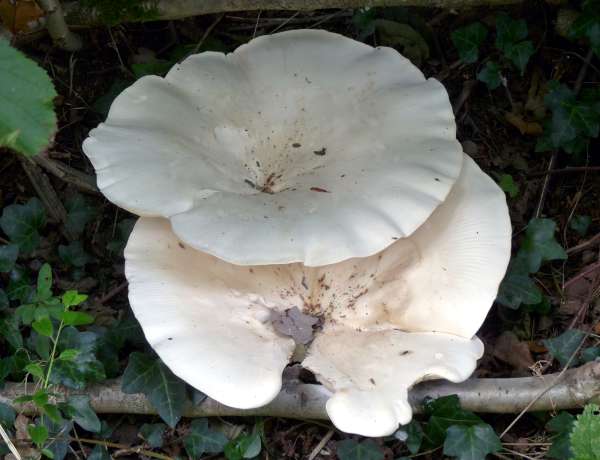
Fully deserving of its common name Giant Funnel, Leucopaxillus giganteus has been known to produce caps 45cm across, although most mature specimens attain a cap diameter of between 15 and 35cm and many very much smaller, which makes size a poor clue to identity. A scattered group of these remarkable fungi is quite a sight, but if you ever come across a fairy ring of Giant Funnels it is an experience you will not forget quickly. (I have seen such a ring only once, and regrettably I did not have a camera to record the spectacle.) Unfortunately these impressive fungi are not at all common.
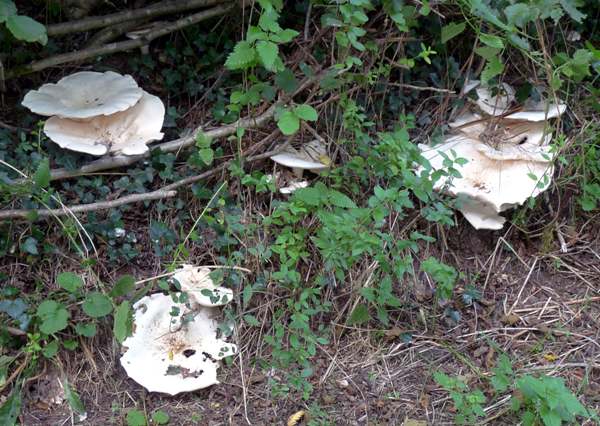
Mainly seen beside hedgerows or on woodland edges, the Giant Funnel can also occur on parkland and in permanent pastures and occasionally on grassy roadside verges; it is in these latter places that arcs or even complete rings of fruitbodies are most likely to be seen.
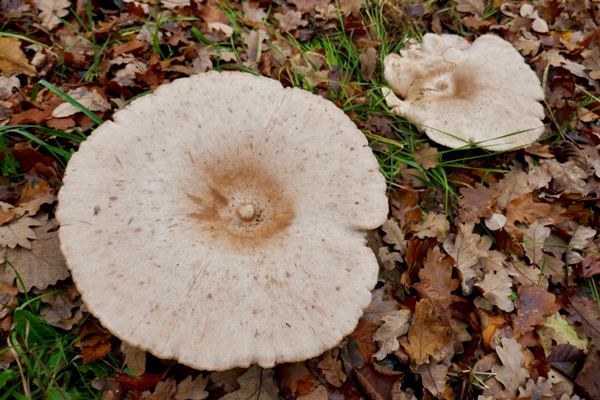
Almost pure ivory white when young, turning buff from the centre at maturity, Giant Funnels look so appetising that the most common question we receive is 'are they edible'? Some authorities say yes, but there are also reports of people suffering from upset stomachs after eating this mushroom.
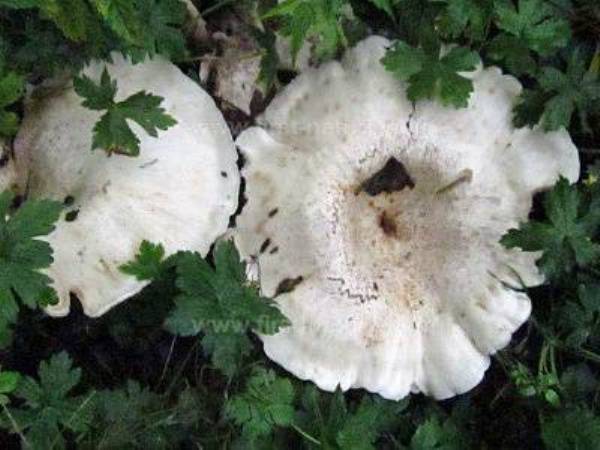
Distribution
Uncommon in Britain, this mushroom also occurs throughout Northern Europe. It is also found in many other parts of the northern hemisphere including North America.
Taxonomic history
This massive mushroom was first described in 1794 by the Oxford (England) botanist John Sibthorp (1758 - 1796), who named it Agaricus giganteus. (In the early years of fungal taxonomy, most of the gilled mushrooms were included initially in the genus Agaricus.) The currently-accepted scientific name dates from 1938, when German-born mycologist Rolf Singer moved the Giant Funnel to the new (at that time) genus Leucopaxillus.
The name Leucopaxillus giganteus was given to this species in 1872 by French mycologist Lucien Quélet. Two years later Elias Magnus Fries renamed it Paxillus giganteus. Other synonyms include Agaricus giganteus Sibth., and Aspropaxillus giganteus (Sibth.) Kühner & Maire.
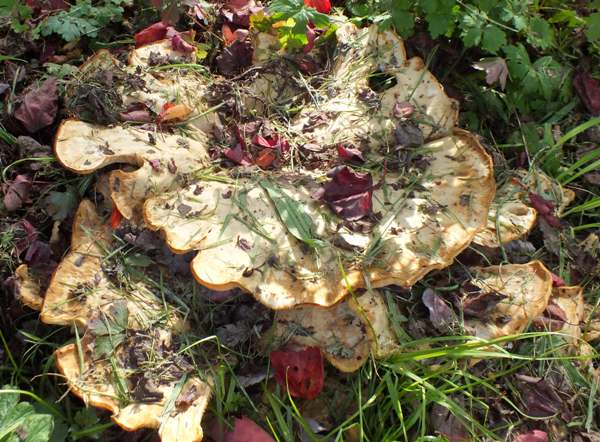
Above: old fruitbodies turn brown from the rim. This 35cm diameter Giant Polypore was seen in the car park of the National Botanic Garden of Wales, Llanarthne, Carmarthenshire. Some of the smaller caps alongside it were a mere 6 to 9cm across.
Etymology
Leucopaxillus is derived from the Greek Leucos meaning white and Paxillus, the name of a genus that includes the toxic toadstool Paxillus involutus, commonly referred to as the Brown Rollrim. Certainly, apart from its larger size, the Giant Funnel Leucopaxillus giganteus does look very much like a white form of Paxillus involutus.
The specific epithet giganteus hardly needs explanation, as this really is a gigantic mushroom... sometimes.
Identification guide
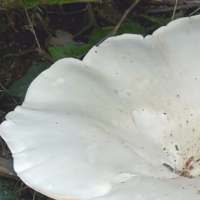 |
Cap
Initially ivory white and convex or flat with finely velvety surface and a down-turned margin, the cap of Leucopaxillus giganteus soon becomes funnel shaped and its surface may lose its velvet texture. The cap gradually turns buff from the centre outwards and may develop circular cracks or small scales in its central region. Most mature specimens are between 15 and 30cm across, although caps as small as 8cm and as large as 45cm have been reported.
The cap flesh is white and rather fragile in fully expanded specimens. |
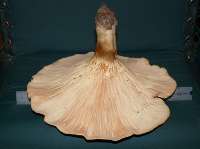 |
Stem
Typically 4 to 6cm tall and 2 to 3cm in diameter, the stem of a Giant Funnel is initially creamy white, turning buff and developing fine longitudinal reddish fibres, particularly towards the top of the stem, whose base is usually not noticeably bulbous.
The white stem flesh is quite tough. |
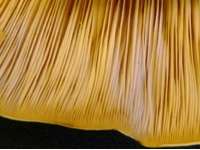 |
Gills
In young specimens of Leucopaxillus giganteus the closely-packed decurrent gills are ivory white, but they darken slightly with age. The picture on the left shows a small section of a cap, in which it is possible to see that some of the gills are forked. |
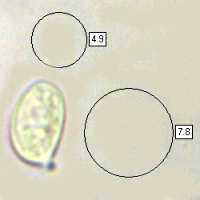 |
Spores
Ellipsoidal, smooth, 6-9 x 4-5.5μm; weakly amyloid.
Spore print
White. |
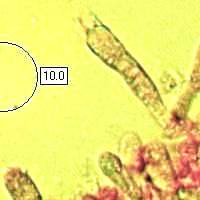 |
Other microscopic characters
The basidia (seen on the left) are mainly four-spored.
Clamp connections are visible in the gill hyphae. |
Odour/taste |
Faint but pleasant odour; taste is also pleasant but not
distinctive. |
Habitat & Ecological role |
Saprobic; in trooping groups or rings beside hedges and in woodland clearings; sometimes in parkland and on grassy roadside verges. |
Season |
August to early November in Britain. |
Similar species |
Clitocybe gibba, the Common Funnel, is much smaller; its spores are inamyloid, and they are pip shaped rather than ellipsoidal.
Clitocybe geotropa, the Trooping Funnel, is usually smaller but with a much taller stem; its spores are inamyloid. |
Cullinary notes
Leucopaxillus giganteus is generally considered edible although its flavour is said to be far from incredible. As with all mushrooms, it is advisable to try a small portion initially, as some people suffer adverse reactions that can include stomach pains, diarrhoea and sweating. Caps are best cut into thin strips before cooking, and these mushrooms are said to be good in risotto dishes as well as in soups and in sauces for serving with fish or meat.
Reference Sources
Fascinated by Fungi, 2nd Edition, Pat O'Reilly 2016, reprinted by Coch-y-bonddu Books in 2022.
Dictionary of the Fungi; Paul M. Kirk, Paul F. Cannon, David W. Minter and J. A. Stalpers; CABI, 2008
Taxonomic history and synonym information on these pages is drawn from many sources but in particular from the British Mycological Society's GB Checklist of Fungi.
Acknowledgements
This page includes pictures kindly contributed by Theresa Bennett, Carolyn Williamson, and DB of Bovey Tracey.
Top of page...
Fascinated by Fungi. Back by popular demand, Pat O'Reilly's best-selling 450-page hardback book is available now. The latest second edition was republished with a sparkling new cover design in September 2022 by Coch-y-Bonddu Books. Full details and copies are available from the publisher's online bookshop...